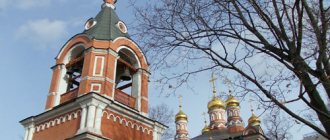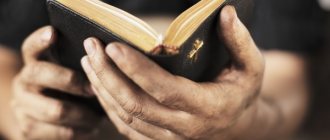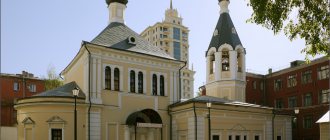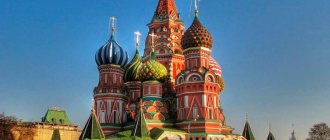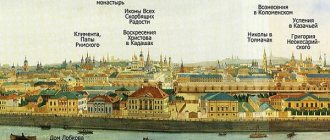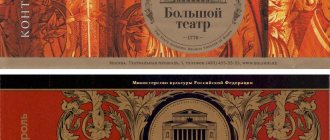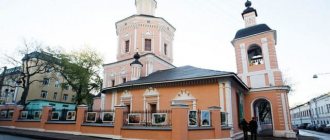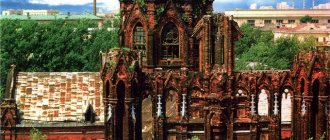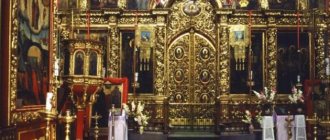Many people know the plot of the painting “Unequal Marriage” by artist Vasily Pukirev, but few can say where the wedding of the characters in the painting took place. Even art historians find it difficult to answer this question.
Parishioners of the Church of the Assumption of the Blessed Virgin Mary in Pechatniki will immediately say that this wedding took place in their church. Whether this is true or not, no one knows, but the urban legend really says that the artist worked on his masterpiece within its walls.
Church of the Assumption of the Blessed Virgin Mary in Pechatniki, Moscow, modern view
The Church of the Assumption of the Blessed Virgin Mary in Pechatniki is a piece of ancient Moscow.
The Church of the Assumption of the Blessed Virgin Mary in Pechatniki is an Orthodox church. He belongs to the Sretensky deanery of the Moscow diocese of the Russian Orthodox Church. Recognized as an architectural and cultural monument and a local landmark.
Many urban legends are associated with the Church of the Assumption of the Blessed Virgin Mary in Pechatniki.
Unequal marriage. Painting. Vasily Pukiriev. 1862 Urban legend says that the wedding, which gave the artist the subject for painting, took place in the Church of the Assumption of the Blessed Virgin Mary in Pechatniki
The church has an ancient history and therefore many urban legends are associated with it. One of them says that it was here that the wedding of a decrepit old man with a young girl took place.
This story served as the prototype for the artist Vasily Pukirev for his famous painting “Unequal Marriage.”
In addition, residents of the area say that before the Revolution, an ancient Jewish coin was kept in the church sacristy before the Revolution - allegedly one of the 30 pieces of silver received by Judas for betraying Christ.
The Church of the Assumption of the Blessed Virgin Mary was built as a parish church for printers
Modern Muscovites are accustomed to calling the area on the outskirts of Moscow Pechatniki, while old-timers know that back in the 17th century there was a Pechatnaya Sloboda between Sretenka and Trubnaya Street.
Here, along the stream, the masters of the Sovereign's Moscow Printing House settled. The church was named after the settlement. By the way, it was specially built as the parish church of this settlement.
Moscow printing yard in the middle of the 17th century. Reconstruction by V.E. Rumyantsev. Lithography. Back in the 17th century, workers of the Sovereign's Moscow Printing House settled between Sretenka and Trubnaya Street. This place was named Pechatnikov, after the name of the settlement they began to call the Assumption Church built here
Information about when the temple was originally built in it has not survived to our time.
Sources give us conflicting information about this. Some call the date 1625, others say 1631.
1659
year of foundation of the Church of the Assumption of the Blessed Virgin Mary in Pechatniki
It is known exactly when the temple was rebuilt in wood. This happened in 1659. It is accepted as the date of foundation of the Church of the Assumption of the Blessed Virgin Mary in Pechatniki.
Scientists were able to establish it only after they studied the inscription found on one of the images located in the church.
History of the temple
Modern Muscovites may find the name of the Assumption Church in Pechatniki unusual, since Pechatniki is usually associated with the area on the outskirts of Moscow, and not the area near the Boulevard Ring. However, the name of the temple is not connected with it: the fact is that in the 17th century, between Sretenka and Trubnaya Street there was a Pechatnaya Sloboda, where the masters of the Moscow Printing House settled. This is how the temple got its name.
The first wooden church in front of the Sretensky Gate of the White City was built by residents of Pechatnaya Sloboda, according to various sources, in 1625 or 1631. It did not stand for very long: already in 1659 it was rebuilt, but again in wood. The stone building of the temple was built in 1695 according to the design of an unknown architect, who designed it in the spirit of Moscow Baroque.
During the 18th century, the church was rebuilt several times: in 1725, parishioners received approval from the Synodal government order for the construction of a warm chapel (built on the right side of the refectory in 1726-1727), which was consecrated in the name of the Beheading of John the Baptist; in 1763, another chapel was built on the other side of the refectory - in the name of St. Nicholas the Wonderworker. In the 1770s, a small chapel appeared at the southern facade of the refectory, and in 1795 the temple was renovated and painted. Unfortunately, in 1812 the temple was plundered by French troops, and all outbuildings were burned, however, the building was soon restored. In 1897-1902, it was reconstructed again: the refectory and chapel were completely rebuilt according to the design of the architect Mikhail Aladin, the bell tower acquired a modern look, and the walls of the temple were decorated with images of saints and scenes from biblical stories.
According to urban legend, before the October Revolution, an ancient Jewish coin was kept in the church sacristy - allegedly one of the 30 pieces of silver received by Judas for betraying Christ.
The Soviet period in the history of the Church of the Assumption of the Blessed Virgin Mary in Pechatniki was quite dramatic. It was closed in 1938; The crosses were removed from the building and the fence was dismantled, and a complete redevelopment was done inside, after which it was transferred to the Arktikproekt trust. Since 1950, the building has housed the “Soviet Arctic” museum, and since 1960 - the permanent exhibition “USSR Navy”. In 1989, the exhibition was converted into the Museum of the Maritime Fleet, the exhibition of which told about the history of shipping in Russia - from its beginnings to the latest developments.
In 1991, the temple building was returned to the Russian Orthodox Church, and in 1994 it was re-consecrated. Later, a Sunday school and a church shop were opened under him.
The stone church in Pechatniki was built in the Moscow Baroque style
Initially, the stone church in Pechatniki had one dome. It was built in the Moscow Baroque style. This type of architecture became fashionable at that time. The Lord favored the Church of the Assumption of the Blessed Virgin Mary.
As is known from the statement presented by General Saltykov to Empress Anna Ioannovna, the church was absolutely not damaged in the fire of 1737.
Church of the Assumption of the Blessed Virgin Mary in Pechatniki. Nowadays. The photograph clearly shows the main elements of the Moscow Baroque: the widespread use of elements of architectural order and the use of centric compositions in temple architecture
The pestilence of 1771 also did not affect her arrival. Other misfortunes also passed him by. As a result, in 1774 the temple was among the fifty-five best parish churches in Moscow.
It should be noted that this happened only thanks to the common work of the parishioners, since the temple never had a rich donor or trustee.
1771
this year the border of the Church of the Assumption in Pechatniki was affected by pestilence
The church grew and became decorated. At the end of 1725, the church community turned to the Synodal Treasury with a request to build a warm chapel. The fact is that the temple was originally built cold.
The chapel was erected on October 3, 1727. It was added to the refectory and consecrated in the name of the Beheading of John the Baptist. On the other side of the refectory, another boundary was built in 1763. It was consecrated in the name of St. Nicholas of Myra of Lycia, the Wonderworker.
Icon depicting St. Nicholas the Wonderworker, painted by Yaroslav Chermak. In 1763, the boundary of the Church of the Assumption in Pechatniki was erected. It was consecrated in the name of St. Nicholas of Myra of Lycia, the Wonderworker
Around 1775, a small chapel was erected near the southern facade. In 1794, the temple in Pechatniki was painted by the painter Nikolai Nikolaevich Tyapkin. In 1798, bells were cast for it: a large one, weighing 177 pounds, and two small ones.
On Easter 1805, a new iconostasis was installed in the church. Around the same time, the sacristy was repaired, a silver frame was made for the temple image, a cross, a gospel, an ark and vessels were purchased.
Thus, the 18th and early 19th centuries can be called the time of the dawn of the Church of the Assumption of the Blessed Virgin Mary in Pechatniki.
Construction of the Temple Limits
The church choir sang harmoniously, and the blessed smoke from the censers rose to the vaults. But one thing prevented parishioners from praying and reading akathists in honor of the Dormition of the Blessed Virgin Mary - the church in Pechatniki was not heated, and in the severe winter frosts the cold in it was bitter. And in 1725, the parishioners decided to add a warm chapel to the temple.
Without hesitation they got down to business, and in 1727 it was built and consecrated. Further work to expand the temple continued in 1763. Another chapel was erected on the other side of the refectory. And eight years later, a small chapel was added to the refectory building.
The remarkable Russian artist, icon painter Nikolai Nikolaevich Tyapkin, decorated the walls of the temple with paintings in 1794, and four years later a huge bell was raised to its belfry. The overall decoration was completed by a new iconostasis installed in 1805, behind which there was a throne consecrated in honor of the Dormition of the Blessed Virgin Mary. The church in Pechatniki was the pride of its parishioners.
The ecclesiastical prosperity of the temple ended in 1812
In 1812, Napoleon, at the head of his army, entered Russia. From that moment on, the prosperity of the Church of the Assumption of the Blessed Virgin Mary in Pechatniki ended. On September 5 of the same year, soldiers of the French army that occupied Moscow plundered and burned the temple.
Outbuildings, houses of temple servants and church shops burned down. The holy altars, almost the entire church library, icons and iconostases, and church utensils also perished in the fire.
Church warden Grigory Dmitriev saved the church utensils of the temple from Napoleon's soldiers.
Moscow fire. A. F. Smirnov. 1813 During the occupation of Moscow by Napoleon's troops, the Church of the Assumption of the Blessed Virgin Mary burned down. At the same time, church elder Grigory Dmitriev was able to save part of the church utensils
At this time, the church elder, Moscow merchant Grigory Dmitriev, performed a heroic act. He saved and returned to the church parishioners 26 pounds of silver and the church utensils he had buried in the ground.
Throughout the entire period of the French occupation of Moscow, the elder did not leave the temple and lived in its bell tower. On September 11, the French began to leave Moscow and soldiers began to break down the door to steal things hidden in the church.
Dmitriev saved her from the robbers this time too. The church things he buried in the ground were later transferred for some time to the Sretensky Monastery for safekeeping.
After the departure of the French, the Church of the Assumption of the Blessed Virgin Mary in Pechatniki was restored for a long time
After the French left Russia, the temple took quite a long time to be restored. So on March 30, 1813, an iconostasis was built in the chapel of John the Baptist. After this, they resumed and on April 24, 1814, the chapel of St. Nicholas was consecrated.
In 1897-1902, the refectory and chapel of the church were completely rebuilt. The author of the architectural project was M.A. Aladin.
Church of the Assumption of the Blessed Virgin Mary in Pechatniki. 1882 From 1882 to 1902, the temple was seriously rebuilt and reconstructed
Aladin designed a bell tower, the lower tier of which was built into the refectory, in the form of a two-tier quadrangle.
It carried an eight-piece link and ended with a small tent. Beginning in 1900, the walls of the side church were painted.
1900
this year we decorated the iconostasis of the Church of the Assumption in prints for the amount of 50,000 rubles
The images were created in the spirit of biblical stories and contained images of saints. In addition, they featured Russian-Byzantine ornaments.
Iconostasis of the Church of the Dormition of the Blessed Virgin Mary in Pechatniki. In 1900, the icons in the temple were renewed. They were painted by artist S.K. Shvarev
The interior decoration of the Church of the Assumption of the Blessed Virgin Mary was supervised by architect V.V. Jordan. The icons in it were painted by the artist S.K. Shvarev.
He also designed the iconostasis of the temple. The cost of all work amounted to more than 50,000 rubles. They were gathered by church elder Pavel Petrovich Sevostyanov among parishioners and benefactors.
During Soviet times, museums and exhibitions were located in the Church of the Assumption of the Blessed Virgin Mary
The Church of the Assumption of the Blessed Virgin Mary in Pechatniki did not escape persecution by the authorities during Soviet times. Like all other places of worship, this Moscow temple was closed after 1917.
This did not happen right away, since the church was popular among the people. In addition, the area of Sretensky Pechatniki was considered proletarian and the Soviet government for some time was not very active in anti-religious work here.
A caricature of renovationism. Magazine "Crocodile". 1923 The last rector of the Church of the Assumption of the Blessed Virgin Mary went over to the renovationists, but this did not save him from exile to the Kazakh camps
The temple was finally closed in 1938. Despite the fact that its last abbot was a Renovationist, he did not escape arrest.
Sent to camps in Kazakhstan for five years. After the temple was closed, the crosses were removed from it, the fence was dismantled and a complete redevelopment of the building was carried out. After that, it was transferred to the management of the Artikproekt trust.
1950 — 1991
During this period, museums and exhibitions were located in the temple building
The temple building was repeatedly transferred to various cultural organizations. Since 1950, the Soviet Arctic Museum has been located here. Since 1960 - the exhibition “USSR Navy”. The exhibition was converted into a museum in 1989.
It housed an exhibition on the history of shipping in Russia. Here there was an opportunity to see exhibits ranging from the first shuttles to the latest nuclear-powered ships.
Cathedral of the Presentation of the Vladimir Icon of the Mother of God. Moscow. Initially, after the return in 1991, the Church of the Assumption of the Blessed Virgin Mary was transferred to the management of the brotherhood of the Sretensky Monastery
In 1991, a representative of the Transfiguration Brotherhood, Father Georgy Kochetkov, petitioned the authorities to transfer the temple to the Russian Orthodox Church. She was satisfied, and the church was re-consecrated in 1994. Then all the exhibitions took them away from her.
At first, the temple belonged to the brotherhood of the Sretensky Monastery. In 1995, its 300th anniversary was celebrated.
Story
The wooden temple was built in front of the Sretensky Gate of the White City by residents of the palace Pechatnaya Sloboda in 1631. The area called “Pechatniki” received its name from the printers who lived here, the masters of the Sovereign Printing House. In the 17th century, printers settled along the stream that flowed between Sretenka and Trubnaya streets.
Sources differ on the date of the first mention of the church; according to some, the wooden church was first mentioned in 1625[2], according to others in 1631[3]. In 1659, the wooden temple was rebuilt, but again in wood. This date is considered the founding date of the temple. The stone temple was built in 1695 in the Moscow Baroque style[3]. Determine the date of construction according to the inscription on one of the images of the temple[3].
At the end of 1725, parishioners of the church turned to the Synodal Treasury with a request to build a warm chapel in the then cold church, for which they received permission on December 17 of the same year. The warm chapel on the right side of the refectory was erected on October 3, 1727, and on October 18 it was consecrated in the name of the Beheading of John the Baptist[2]. In 1763, on the other side of the refectory, another chapel was erected in the name of St. Nicholas the World of Lycian Wonderworker. Around 1775, a small chapel was built near the southern façade of the refectory. In 1795, the temple was renovated and painted. In 1812, the Church of the Assumption of the Blessed Virgin Mary was plundered by the French army, and all outbuildings were burned. The houses of the temple employees and all the church shops burned down. In 1813, an iconostasis was made and consecrated in the church. In 1897-1902, the refectory and chapel were completely rebuilt according to the design of the architect M. A. Aladin. The bell tower, the lower tier of which is built into the refectory, is a two-tier quadrangle carrying an octagon of bells, topped with a small brick tent. The walls were decorated with images of saints and paintings of biblical stories.
The temple operated until 1938; its last rector before his arrest in the same year was the Renovationist Metropolitan of Moscow Tikhon (Popov). After the closure, the crosses were removed from the temple, the fence was dismantled, and a complete redevelopment was done inside. The temple building was given to the Artikproekt trust, since 1950 the temple building housed the “Soviet Arctic” museum, since 1960 - the exhibition “USSR Navy”, in 1989 it was transformed into a museum, which housed an exhibition on the history of shipping in Russia from the first shuttles to the newest nuclear-powered ships.
In 1991, at the request of the Transfiguration Brotherhood of Father Georgy Kochetkov, the temple was transferred to the Russian Orthodox Church. It was re-consecrated in 1994.
Father Georgy Kochetkov was the rector of the church before the conflict situation on June 28, 1997. In 1997, before the conflict, Father Mikhail Dubovitsky concelebrated with him, and after Father Georgy Kochetkov was banned from serving[4], Archpriest Oleg Klemyshev became the rector of the church, who still serves in the church. In 2000, by another decree of Patriarch Alexy II, the bans against Father Georgy Kochetkov were lifted[5].
According to legend, the wedding of a decrepit old man and a young girl took place in this church, which served as the theme for the artist V.V. Pukirev for his famous painting “Unequal Marriage.” In the church sacristy there is kept a Jewish silver coin, according to legend, one of those that was given to Judas for the betrayal of Jesus Christ.
There is a church shop in the church, there is a Sunday school in which children study liturgics, the history of church art, the history of Orthodox Moscow, and the Church Slavonic language.
A scandalous incident is associated with the former rector of the temple, Father Georgy Kochetkov.
The initiator of the return of the Church of the Assumption of the Blessed Virgin Mary in Pechatniki, Father Georgy Kochetkov, became its rector and served there until June 28, 1997. On this day, a conflict occurred between him and Father Mikhail Dubovitsky within the walls of the church.
The fact is that Father Mikhail held a service on this day. The altar servers did not like the fact that he moved away from her, despite the fact that the order of the service was blessed by the rector of the temple.
Spiritual guardian of the Transfiguration Brotherhood, Fr. Georgy Kochetkov. After the incident that occurred in the Church of the Assumption of the Blessed Virgin Mary on June 28, 1997, Father George left his post as rector
According to supporters of Father Mikhail Dubovitsky, altar servers devoted to Father George grabbed Father Mikhail, tore off his cross and priestly robes, and beat him. The rector of the church called the police and psychiatric services.
He explained that Father Mikhail Dubovitsoky suffered from acute psychosis and the altar workers had to take him out of the altar in order to stop possible outrages.
His Holiness Patriarch of Moscow and All Rus' Alexy II, having examined the case, banned Father Georgy Kochetkov from serving. In 2000, by another decree, he lifted all the restrictions against him.
Unfortunately, the conflict between the parties continues to this day. Father George's opponents accuse him of heresy and creating a sect, but he, in turn, denies all accusations.
Currently, the Church of the Assumption is considered the cultural center of the Printers and the Sretensky deanery
In our time, the Church of the Assumption of the Blessed Virgin Mary is a recognized cultural and religious center in Pechatniki, Sretensky deanery. In addition to Father Oleg Klemyshev, the rector, Archpriest Gennady Zerin serves in the church.
There is a church shop at the temple, as well as a Sunday school. At school, children study the history of church art, the history of Orthodox Moscow, and the Church Slavonic language.
Divine service in the Church of the Dormition of the Blessed Virgin Mary in Pechatniki. 2006 Services are constantly held in the temple. Its schedule can be found on the parish website
The following shrines are kept in the Church of the Assumption of the Blessed Virgin Mary:
- cathedral icon of the Optina Elders with particles of the relics of the 12 Optina Elders;
- icon of the Hieromartyr Nikolai Tolgsky, the last dean of Sretensky forty, shot in 1937;
- icon of St. Peter, Metropolitan of Moscow with a particle of relics;
- icons of the holy Venerable Job of Pochaev and the holy Venerable Amphilochius of Pochaev with particles of relics.
Official website of the Church of the Assumption of the Blessed Virgin Mary in Pechatniki
Divine services are constantly held in the temple, sacraments and services are performed. The service is held as scheduled. More detailed information about the church and the life of the parish can be found on its website.
On other days the Temple is open from 9:30 to 18:30. Parish contact details: tel. (495)624-3510.
The Church of the Assumption of the Blessed Virgin Mary in Pechatniki is located at Sretenka Street, building 3, building 4 (on the corner of Sretenka and Rozhdestvensky Boulevard).
Layout of the Church of the Assumption of the Blessed Virgin Mary in Pechatniki Sretensky Deanery.
You can get to it on foot from the Turgenevskaya and Sukharevskaya metro stations on the Kaluzhsko-Rizhskaya line, Sretensky Boulevard and Trubnaya on the Lyublinsko-Dmitrovskaya line, as well as Chistye Prudy on the Sokolnicheskaya line.
By leaving a comment, you accept the user agreement
Church of the Dormition of the Mother of God in Pechatniki
Share
Address: Sretenka street, building 3/27
The Church of the Assumption of the Mother of God in Pechatniki is located on the corner of Sretenka and Sretensky Boulevard. And its name is accompanied by a clarification - in Pechatniki. A clarification that seems to speak for itself.
This temple - at first, of course, wooden - was built in front of the Sretensky Gate of the White City by residents of the palace Pechatnaya Sloboda, presumably in 1631. It was no coincidence that the settlement was a printing settlement - here, in Pechatniki, the masters of the Sovereign Printing House lived. It was here in 1564 that the famous pioneer printer Ivan Fedorov published the first Russian book, “The Apostle.”
By the way, the printing house was established and built by the decision of Ivan the Terrible himself. Sovereign Ivan Vasilyevich, no matter how one treated him, was a widely and deeply educated man. It is not for nothing that, say, his letters to the traitor Prince Kurbsky are considered the first example of Russian journalism, and the stichera written by him - that is, chants in Orthodox worship - very highly characterize the tsar as a composer and poet. Yes, you heard right – the composer. At the end of the 80s, she released a double album of stichera by Ivan the Terrible - believe me, they are worth listening to.
Let us return, however, to the temple. In 1659, the wooden temple was rebuilt, but it still remained wooden. The stone temple was built in 1695 in the Moscow Baroque style. Shortly before the war of 12, the temple was fairly renovated and painted, but, alas, during the French occupation the temple was badly damaged, and the French burned all the outbuildings. The clergy houses and all the church shops also burned down. In 1813, the iconostasis in the church was rebuilt and consecrated. And at the turn of the 19th-20th centuries, the refectory and chapel were completely rebuilt according to the design of the architect Aladin. After the revolution, the temple was closed. The building was given to the Arktikproject trust; since 1950, it housed the “Soviet Arctic” museum, and later the “USSR Navy” museum.
In 1991, the temple was transferred to the Russian Orthodox Church and re-consecrated in 1994. Presumably, it was in this temple that the artist Vasily Pukirev saw the wedding of an old man with a young girl, which he then depicted in the famous canvas “Unequal Marriage.” And finally. The cathedral icon of the Church of the Dormition of the Mother of God in Pechatniki is an icon with particles of the relics of the 12 Optina elders.
Contacts: Church of the Assumption of the Blessed Virgin Mary in Pechatniki
Address: Sretenka street, building 3/27
Nearest metro stations: Sretensky Boulevard (320 m) Turgenevskaya (420 m) Chistye Prudy (540 m)
Website address: https://www.usp-pech.orthodoxy.ru/
Driving directions:
